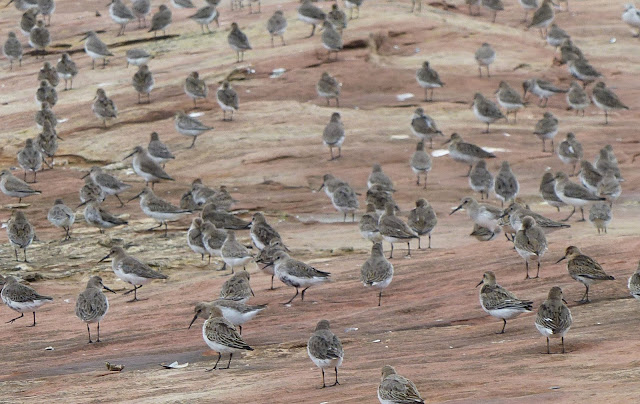Weather: SE force 2/3, heavy rain in the afternoon.
General migration was good in the morning before the heavy rain arrived around noon. A few Meadow Pipits were passing through and there were several Goldcrests and a single Chiffchaff calling in the gardens, and an unexpected surprise was a Willow Warbler retrapped as none had been ringed for over a week now.
Two Skylarks arrived together and flew about the island.Two Pied and a Grey Wagtail flew over and a Reed Bunting called as it came to ground.
Three Wheatears were found today.
Two Ravens paid a visit, possibly the same as have been here often recently.
A Magpie arrived and sat on top of the lookout and then the 'heli' trap, not a rare bird but Hilbre sometimes only gets about 3 or 4 records a year.
Rock Pipits present included ones that are ringed in our colour ringing scheme and ones that are not.
The very large tide today meant waders had few options on where to roost and counts included 8,000 Oystercatchers, 250 Grey Plover, 122 Curlew, 20 Redshank, 50 Ringed Plover, 45 Turnstone, 1,500 Knot and 3,000 Dunlin, some of which roosted at the north end.
The persistent afternoon rain made a high tide sea watch from the hide a sensible option, and the choice was a good one with records of 18 Gannets, 11 Red-throated Divers, 53 Guillemots, 40 Common Scoter, 4 Great Crested Grebes, a single Arctic Skua and 5 Sandwich and 6 Common Terns. Two Eiders were off the north end early but turned out to be immature males rather than the 2 females that have been about.
The adult male then Eider appeared on the west side just as
the tide was cutting through and later on the 2 females joined the 2 immature males at the north end. An unexpected find was this huge Convolvulus Hawkmoth found in the S K paddock.
Convolvulus Hawkmoth is among the very largest of british moths, often with a wingspan of over 4 inches so members were astonished to see this one resting on the wood inside the box of the SK trap. It is extremely scarce in this part of the country as most are the offspring of insects that have flown north from Africa and arrived on the south and east coast. On the way off the island an adult winter Mediterranean Gull sat on the shore towards the marine lake.
In the same place after the tide no less than 41 Little Egrets were counted in our recording area, an extremely large gathering.
Photos AEH, AS



























No comments:
Post a Comment